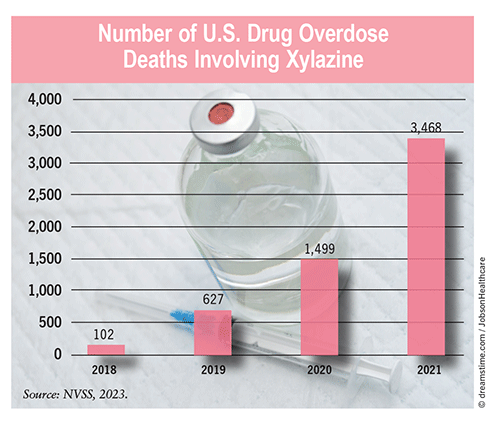US Pharm. 2024;49(3):14.
In 2023, the Office of National Drug Control Policy declared the adulteration of fentanyl with xylazine an emerging threat and issued a National Response Plan to address the alarming increase in xylazine-involved drug overdose deaths. Xylazine, a nonopioid veterinary tranquilizer not approved for human use, is a liquid solution for injection that can be salted or dried into a powder. It has been increasingly detected in the U.S. illegal drug supply as a white or brown powder mixed into other powders or pressed into pills along with other drugs to lengthen euphoric effects. The FDA is investigating whether xylazine is being illicitly produced or diverted from animal drug supplies.

Trends: The emergence of xylazine across the country appears to have followed the same path as fentanyl: from the Northeast to the South, then into illegal drug markets in the West. This pattern supports concerns that xylazine will likely continue to be used as an adulterant and detected in illicit fentanyl supplies. In fact, the CDC and the Drug Enforcement Administration report that forensic laboratory identification of xylazine increased in every region of the U.S. from 2020 to 2021, with the greatest increases in the South (193%) and West (112%).
Drug Overdose Deaths: Xylazine continues to be linked to a growing number of drug overdose deaths nationwide. Deaths involving xylazine rose nearly 20-fold between 2015 and 2020 in all major U.S. regions. From 2020 to 2021, increases in xylazine-involved overdose deaths of 103%, 516%, 750%, and 1,127% were seen in the Northeast, Midwest, West, and South, respectively. In addition, the CDC reported a 276% increase (from 2.9% to 10.9%) in the monthly percentage of illegally manufactured fentanyl–involved deaths with xylazine detected between January 2019 and June 2022. The age-adjusted rate of drug overdose deaths involving xylazine in 2021 was 35 times higher than the 2018 rate (from 0.03 to 1.06 per 100,000 standard population, respectively). For males, the rate of drug overdose deaths involving xylazine increased from 0.05 to 1.55 per 100,000 standard population from 2018 to 2021; for females, the rate increased from 0.01 to 0.57 per 100,000 standard population.
Testing and Reporting: The lack of routine toxicologic screenings for xylazine detection and the similarity of signs and symptoms between xylazine and opioid use make it challenging to determine how to identify and counteract xylazine’s effects. Naloxone administration is recommended for suspected drug overdoses because xylazine has most commonly been found in combination with fentanyl in illicit drug supplies. Many state legislatures are taking action to prevent drug overdose deaths by expanding public access to xylazine and fentanyl test strips. The FDA encourages healthcare professionals and patients to report any adverse event experienced as a result of possible xylazine exposure to its MedWatch adverse event reporting program.
The content contained in this article is for informational purposes only. The content is not intended to be a substitute for professional advice. Reliance on any information provided in this article is solely at your own risk.
To comment on this article, contact rdavidson@uspharmacist.com.






